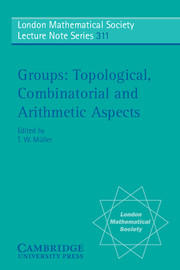Book contents
- Frontmatter
- Contents
- List of authors and participants
- Preface
- 1 Reductive groups as metric spaces
- 2 Finiteness properties of groups acting on twin buildings
- 3 Higher finiteness properties of S-arithmetic groups in the function field case I
- 4 Controlled topology and group actions
- 5 Finiteness properties of soluble S-arithmetic groups – A survey
- 6 Topology in permutation groups
- 7 Euler characteristics of discrete groups
- 8 Intersections of Magnus subgroups of one-relator groups
- 9 A minimality property of certain branch groups
- 10 Lattices with non-integral character
- 11 Some applications of probability in group theory
- 12 Parity patterns in Hecke groups and Fermat primes
- 13 Automorphisms of the binary tree: state-closed subgroups and dynamics of 1/2-endomorphisms
- 14 The mapping class group of the twice punctured torus
- 15 Kac–Moody groups: split and relative theories. Lattices
- 16 On the finite images of infinite groups
- 17 Pseudo-finite generalized triangle groups
6 - Topology in permutation groups
Published online by Cambridge University Press: 04 November 2009
- Frontmatter
- Contents
- List of authors and participants
- Preface
- 1 Reductive groups as metric spaces
- 2 Finiteness properties of groups acting on twin buildings
- 3 Higher finiteness properties of S-arithmetic groups in the function field case I
- 4 Controlled topology and group actions
- 5 Finiteness properties of soluble S-arithmetic groups – A survey
- 6 Topology in permutation groups
- 7 Euler characteristics of discrete groups
- 8 Intersections of Magnus subgroups of one-relator groups
- 9 A minimality property of certain branch groups
- 10 Lattices with non-integral character
- 11 Some applications of probability in group theory
- 12 Parity patterns in Hecke groups and Fermat primes
- 13 Automorphisms of the binary tree: state-closed subgroups and dynamics of 1/2-endomorphisms
- 14 The mapping class group of the twice punctured torus
- 15 Kac–Moody groups: split and relative theories. Lattices
- 16 On the finite images of infinite groups
- 17 Pseudo-finite generalized triangle groups
Summary
Introduction
In a lecture at Oberwolfach in the 1980s with the title “Topology in permutation groups”, Helmut Wielandt defended the proposition that topology in permutation groups is of no use, and came to the conclusion that (with the addition of the word “almost”) this was indeed the case. Wielandt made it clear that he was not speaking about the topology of permutation groups. (There is a natural topology on the symmetric group, namely the topology of pointwise convergence. In the case of countable degree, the open subgroups are those lying between the pointwise and setwise stabiliser of a finite set, and the closed subgroups are the automorphism groups of first-order structures.) Nevertheless, many in the audience felt that Wielandt's conclusion was too pessimistic. Since then, further results have supported this view. The present paper is a survey of some of these results. I begin with an account of Wielandt's own work on the subject, the connection of non-Hausdorff topologies preserved by G and the notions of primitivity and strong primitivity. The next topic is a theorem of Macpherson and Praeger, according to which a primitive group which preserves no non-trivial topology is highly transitive. Their proof uses some deep results from model theory. I give an elementary argument to replace part of the proof.
Some topologies low in the separation hierarchy can be interpreted as relational structures (specifically, preorders), so that their homeomorphism groups are closed subgroups of the symmetric group.
- Type
- Chapter
- Information
- GroupsTopological, Combinatorial and Arithmetic Aspects, pp. 93 - 105Publisher: Cambridge University PressPrint publication year: 2004



